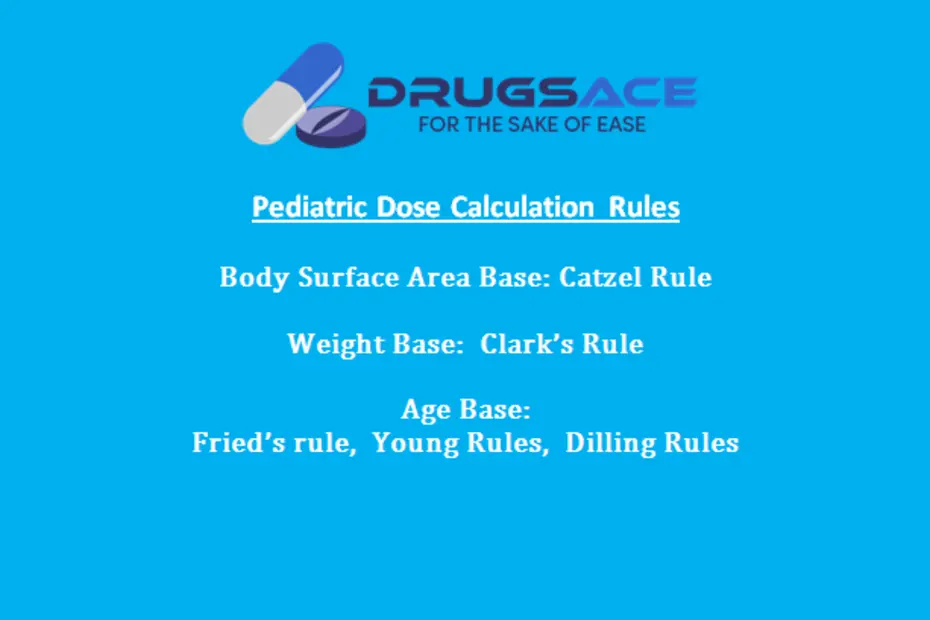Table of Contents
Introduction
After the completion of this module you will be able to:
- Calculate the proper dose for a child when given the adult dose of a drug using the following methods:
- Catzel Rule (Nomogram Method) (Using a Child’s Body Surface Area)
- Fried’s Rule (Using the Child’s Age in Months (FOR UNDER 1YR OF AGE))
- Young’s Rule (Using the Child’s Age in Years (FOR 1YR – 12 YR OF AGE))
- Dilling Rules (Using the Child’s Age in Years ( UPTO 20YR OF AGE))
- Clark’s Rule (Child’s Weight in Pounds)
- Calculate the proper dose for a patient given the recommended dose of a drug.
Pediatric Dosing
Dosages for medication administration to pediatric patients are almost always determined by the patient’s size (height and weight). However, most reference manuals for medications focus primarily on the adult dosages. Therefore, the healthcare provider must be able to determine the appropriate dosage for the pediatric patient when given the adult dosage. Several different methods may be used to determine the correct dosage of medication for a pediatric patient. The methods that will be discussed in this module are:
-
- Catzel Rule (Nomogram Method)
- Fried’s Rule
- Young’s Rule
- Dilling Rules
- Clark’s Rule
Important Conversions
| Solid Conversions | Liquid Conversions |
| gr 1 = 60 mg | 30 ml = 1 oz |
| gr 15 = 1 g | 1 tsp = 5 mL |
| 2.54 cm = 1 in | 1 standard measuring cup = 240 ml |
| 2.2 lb = 1 kg | |
| Mass | Volume |
| mcg ← mg ← g ← kg ( x by 1,000) | mcl ← ml ← L ← kl ( ( x by 1,000) |
| mcg → mg → g → kg ( ÷ by 1,000) | mcl → ml → L → kl ( ÷ by 1,000) |
| Ib ← kg ( x by 1,000) | |
| Ib → kg ( ÷ by 1,000) | |
| Time | Temperature Conversions |
| min ← hr ( x by 60) | °C =(°F -32)+1.8 |
| min → hr ( ÷ by 60) | °F =(°C x 1.8) + 32 |
Pediatric Dose Calculation Rules
Body Surface Area Base:
Catzel Rule (Nomogram Method)
It is best when calculation is not possible by body weight and it is the more accurate and used in chemotherapeutic agents
The Nomogram method is utilized to determine the correct pediatric medication dosage based specifically on the patient’s size. The patient’s size is identified as body surface area (BSA) in meters squared (m²). The average adult client (weighing 150 – 154 lbs) will have a BSA of 1.73m². The nomogram chart can be used to identify the patient’s BSA based on their height and weight (in. and lbs. or cm and kg).
Catzel Rule: The surface area is determined where a straight line connecting the patient’s height and weight crosses over the BSA column.
One can also calculate Body Surface Area by using BSA Formulas
BSA Formula
- m² = √Weight (kg) × height (cm) /3600
- m² = √Weight (Ibs) × height (inches) /3131
Once the BSA of the patient is determined the following formula can be used to calculate the correct pediatric dosage:
Catzel Rule
Formula: Body Surface Area of child/ Adult S.A (1.73m²) × adult dose
Age Base:
Fried’s rule
Fried’s rule is a method of estimating the dose of medication for a child by dividing the child’s age in months by 150 and multiplying the result by the adult dose.
Commonly used for neonates
Fried’s Rule (Using the Child’s Age in Months (FOR UNDER 1YR OF AGE))
Formula: [age (months)/150] × adult dose
Young Rules
Young’s Rule: Can be applied quickly approach a situation in which the patients weight is unknown and easy to remember because young refers to age.
Young’s Rule (Using the Child’s Age in Years (FOR 1YR – 12 YR OF AGE))
Formula: Age in years / age + 12 × Adult dose
Dilling Rules
Dilling Rules: It is the simplest and easiest and formula for child dose calculation
Dilling Rules (Using the Child’s Age in Years ( UPTO 20YR OF AGE))
Formula: Age in years / 20 × adult dose
Weight base:
Clark’s Rule
Clark’s Rule is a medical term referring to a procedure used to calculate the amount of medicine to give to a child aged 2-17. The procedure is to take the child’s weight in pounds, divide by 150lbs, and multiply the fractional result by the adult dose to find the equivalent child dosage.
It is best when the calculation is not possible from age, also more commonly used
Formula:
- Weight (kg)/ 70 × adult dose or
- Weight(pounds)/150* adult dose


Leave a Reply